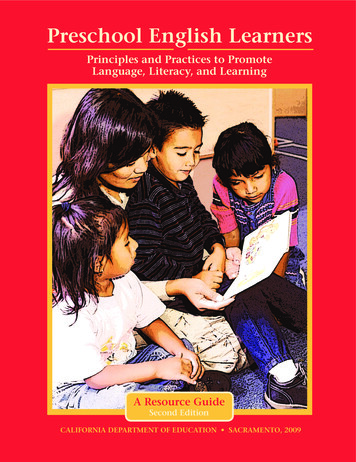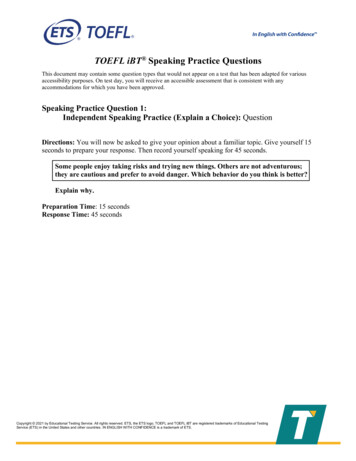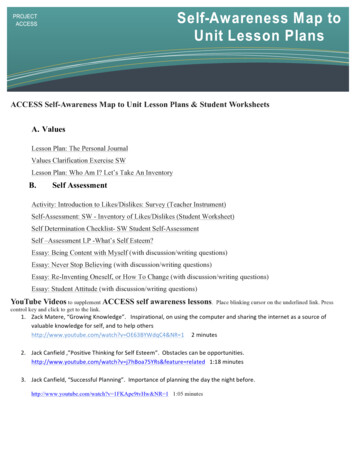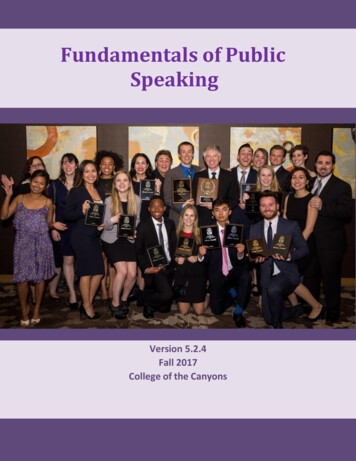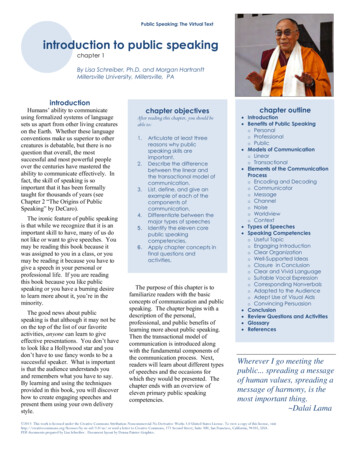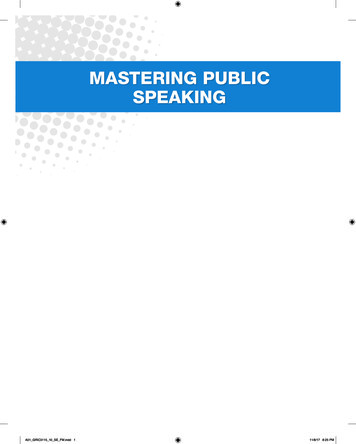
Transcription
SELF-ASSESSMENT OF STUDENTS' SPEAKING SKILLSA THESIS SUBMITTED TOTHE GRADUATE SCHOOL OF SOCIAL SCIENCES OFMIDDLE EAST TECHNICAL UNIVERSITYBYHELIN BAŞAKIN PARTIAL FULFILLMENT OF THE REQUIREMENTSFORTHE DEGREE OF MASTER OF ARTSINTHE DEPARTMENT OF ENGLISH LANGUAGE TEACHINGFEBRUARY 2019
Approval of the Graduate School of Social SciencesProf. Dr. Tülin GençözDirectorI certify that this thesis satisfies all the requirements as a thesis for the degree ofMaster of Arts.Prof. Dr. Çiğdem Sağın ŞimşekHead of DepartmentThis is to certify that we have read this thesis and that in our opinion it is fullyadequate, in scope and quality, as a thesis for the degree of Master of Arts.Prof. Dr. Çiğdem Sağın ŞimşekSupervisorExamining Committee MembersAssoc. Prof. Dr. Nurdan Gürbüz (METU, FLE)Prof. Dr. Çiğdem Sağın Şimşek (METU, FLE)Assoc. Prof. Dr. Suzan Kavanoz(Yıldız Teknik Uni., FLE)
I hereby declare that all information in this document has been obtained andpresented in accordance with academic rules and ethical conduct. I also declarethat, as required by these rules and conduct, I have fully cited and referencedall material and results that are not original to this work.Name, Last Name : Helin BAŞAKSignatureiii:
ABSTRACTSELF-ASSESSMENT OF STUDENTS' SPEAKING SKILLSBAŞAK, HelinM.A., English Language TeachingSupervisor: Prof. Dr. Çiğdem Sağın ŞimşekFebruary 2019, 131 pagesThis study has the main aim to examine whether there is a significant differencebetween students’ self-assessment of their speaking skills and teachers’ assessmentof students’ speaking skills. In addition, the study also aims to determine whetherstudents and teachers assess different components of speaking skill such asgrammar, vocabulary, pronunciation, and fluency significantly different from eachother or not. Finally, the study aims to investigate whether students’ self-assessmentshow differences in terms of their proficiency level in English, gender, and exposureto English outside the school. The data were collected via a self-assessment scalegiven to the participants and English language teachers’ assessment of theparticipants based on a speaking assessment scale. The results show that the teachersand the students assess the speaking skills significantly differently from each other.The mean score of the teachers’ assessment is 79.2 out of 100 while the mean scoreof the students’ self-assessment is 61.7. These scores conclude that the teachersassess the students’ speaking skills higher than the students themselves. In anutshell, students evaluate their vocabulary, grammar, fluency, pronunciation andcommunication skills lower than their teachers. The results also show how insecureiv
the students feel about their speaking skills as a whole. In addition, the results showthat the students’ self-assessment of their speaking skills and teacher assessment ofspeaking skills change depending on the students’ level of proficiency, gender andexposure to English outside the classroom.Keywords: Language assessment, self-assessment, learner autonomyv
ÖZÖĞRENCİLERİN KONUŞMA BECERİLERİNİ ÖZ DEĞERLENDİRMESİBAŞAK, HelinYüksek Lisans, İngiliz Dili Eğitimi BölümüTez Yöneticisi: Prof. Dr. Çiğdem Sağın ŞimşekŞubat 2019, 131 sayfaBu çalışma,öğrencilerin enlerin öğrencilerin konuşma becerilerini değerlendirmesi arasında anlamlıbir fark olup olmadığını incelemeyi amaçlamaktadır. Buna ek olarak, bu çalışmaaynı zamanda, öğrencilerin ve öğretmenlerin dilbilgisi, kelime bilgisi, telaffuz veakıcılık gibi farklı konuşma becerilerini birbirinden önemli ölçüde farklıdeğerlendirip değerlendirmediklerini belirlemeyi amaçlamaktadır. Son olarak, buçalışma öğrencilerin öz değerlendirmelerinin İngilizce yeterlilik düzeyleri, cinsiyetve okul dışında İngilizce'ye maruz kalma açısından farklılık gösterip göstermediğiniaraştırmayı amaçlamaktadır. Veriler katılımcılara verilen bir öz değerlendirmeölçeği ve İngilizce öğretmenlerinin, katılımcıları bir konuşma değerlendirmeölçeğine göre değerlendirmesi yoluyla toplanmıştır. Sonuçlar, öğretmenlerin veöğrencilerin konuşma becerilerini birbirinden önemli ölçüde farklı olarakdeğerlendirdiğinigöstermektedir. � 100 üzerinden 79,2 iken, öğrencilerin öz değerlendirme puan ortalaması61,7'dir. Bu puanlar, öğretmenlerin öğrencilerin konuşma becerilerini öğrencilerdendaha yüksek değerlendirdiği sonucuna varmıştır. Özetle, öğrenciler kelime,vi
dilbilgisi, akıcılık, telaffuz ve iletişim becerilerini öğretmenlerinden daha düşükolarak değerlendirirler. Sonuçlar ayrıca öğrencilerin bir bütün olarak konuşmabecerileri hakkında ne kadar özgüvensiz hissettiklerini gösterir. Buna ek özdeğerlendirmelerininveöğretmenlerin konuşma becerilerini değerlendirmelerinin, öğrencilerin yeterlilik,cinsiyet ve sınıf dışındaki İngilizce'ye maruz kalma düzeylerine bağlı olarakdeğiştiğini göstermektedir.Anahtar sözcükler: Dil değerlendirmesi, Öz değerlendirme, Öğrenci Özerkliğivii
To my father who never left me, andto my mother who did more than my right hand.viii
ACKNOWLEDGEMENTSI would like to express my deepest gratitude to her supervisor Assoc. Prof. ÇiğdemSağın-Şimşek for her patience, advice, feedback, criticism and insight throughoutthe study. It would be impossible to accomplish this research without her guidanceand encouragement.I would also like to thank to Assist. Prof. Nurdan Gürbüz and Assist. Prof. SuzanKavanoz, the rest of the thesis committee, for their fruitful suggestions andcomments.The support and encouragement of my dearest friend Eda Yılmaz have always beenappreciated. She has always been and will be there for me to encourage me, cheerme up and hold my hand in every possible situation ever imagined.I would also like to thank to my brother Serhat Başak, my friends Bahar Yavçan,Burcu Kabadayı, Betül Baldan, and İmral Tuç for their endless support during thisdifficult process. This thesis could not be completed without their motivation.Last but not least, I wish to express my heartfelt gratitude to Ferhat Turhal whomade it possible for me to complete this thesis with his never-endingencouragement. He always continued to motivate me and experienced this processwith me till the last moment.ix
TABLE OF CONTENTSPLAGIARISM. iiiABSTRACT . ivÖZ . viACKNOWLEDGEMENTS . ixTABLE OF CONTENTS . xLIST OF TABLES . xivLIST OF FIGURES . xviLIST OF ABBREVIATIONS . xviiCHAPTER 1INTRODUCTION . 11.1. Purpose and Background to the Study . 11.2. The Significance of the Study . 41.3. Research Setting . 51.4. Research Questions. 61.5. Assumptions . 62. LITERATURE REVIEW . 82.1. Introduction . 82.2. Assessment and Testing. 82.2.1. Summative Assessment . 92.2.2. Formative Assessment . 102.3. Self-Assessment. 112.3.1. Reliability and Validity of Self-Assessment . 162.3.2. Models of Self-Assessment . 202.3.2.1. Learner-Prepared Self-Assessment . 202.3.2.2. Self-Assessment Checklists . 212.3.2.3. Informal Self-Assessment Devices . 21x
2.3.2.4. Learner Record-Keeping Self-Assessment . 212.3.2.5. Strong and Weak Models of Self-Assessment . 222.3.2.6. Performance-Oriented and Development-Oriented SelfAssessments . 232.3.3. Aims of Self-Assessment . 262.3.4. Self- Assessment of Language Skills . 282.3.4.1. Reading . 282.3.4.2. Listening . 312.3.4.3. Grammar . 332.3.4.4. Writing . 342.4. Testing Speaking . 372.4.1. Ways of Testing Speaking . 372.4.2. Components Tested in Speaking . 432.4.3. Self – Assessment of Speaking Skills . 452.5. Previous Studies on Self-Assessment of Speaking Skills . 473. METHODOLOGY . 523.1. Introduction . 523.2. Aims of the Study . 523.3. Setting . 523.4. Research Question . 553.5. Participants . 553.6. Data Collection Tools and Procedure . 563.6.1. The Self-Assessment Rubric . 573.6.2. Piloting The Self-Assessment Rubric. 573.6.3. Teachers’ Speaking Exam Grades . 583.6.4. Data Collection Procedure. 593.7. Data Analysis. 594. RESULTS . 614.1. Introduction . 614.2. Relationship Between the Students’ Self-Assessment Scores and theTeachers’ Assessment Scores . 61xi
4.2.1. Is There a Significant Difference Between Students’ Self-AssessmentScores and Teachers’ Assessment Scores Regarding Students’Speaking Skills in English? . 624.2.2. Self-Assessment and Teacher Assessment of Components ofSpeaking Skills . 634.2.2.1. Assessment of Grammar . 634.2.2.2. Assessment of Vocabulary . 654.2.2.3. Assessment of Fluency. 674.2.2.4. Assessment of Pronunciation . 684.2.2.5. Assessment of Communication Skills. 704.2.2.6. Assessment of Overall Speaking Skills. 724.3. Relationship Between Self-Assessment, Teacher Assessment and LanguageProficiency Levels . 734.4. Relationship Between Self-Assessment and Gender . 774.4.1. Is There a Significant Difference Between Female and MaleStudents’ Self-Assessment of Their Speaking Skills? . 774.4.2. Do Teachers’ Assessment Scores Regarding Students’ SpeakingPerformance Show a Significant Difference in Relation to Students’Gender? . 784.5. Extracurricular Activities’ Effect on Self-Assessment . 784.5.1. Relationship Between Watching TV Series in English and SelfAssessment of Speaking Skills. 794.5.2. Relationship Between Listening to Music/Radio in English and SelfAssessment of Speaking Skills. 804.5.3. Relationship Between Playing Online/Video Games in English andSelf-Assessment of Speaking Skills . 814.5.4. Relationship Between Visiting Websites in English and SelfAssessment of Speaking Skills. 835. DISCUSSION AND CONCLUSION . 855.1. Introduction . 855.2. Overview of the Study . 855.2.1. The Relationship Between the Students’ Self-Assessment and theTeachers’ Assessment . 86xii
5.2.2. Self-Assessment of the Components of Speaking Skills. 895.2.3. The Relationship Between the Self-Assessment of Speaking Skillsand Proficiency Levels of the Students . 915.2.4. The Relationship Between Self-Assessment and Gender . 925.2.5. The Relationship Between Self-Assessment and ExtracurricularActivities . 945.3. Conclusion . 955.4. Limitations and Implications for Further Research . 97REFERENCES . 99APPENDICES. 110APPENDIX A: THE SELF-ASSESSMENT RUBRIC . 110APPENDIX B: TEACHERS’ RUBRIC FOR SPEAKING EXAM . 114APPENDIX C: ETİK İZİN FORMU/ETHICS PERMISSION FORM . 116APPENDIX D: TURKISH SUMMARY / TÜRKÇE ÖZET . 118APPENDIX E: TEZ İZİN FORMU/THESIS PERMISSION FORM . 132xiii
LIST OF TABLESTable 2.1. Models of Self-Assessment . 24Table 2.2. Band Descriptors for IELTS Speaking Exam . 41Table 2. 3. TOEFL Exam Speaking Band Descriptors . 41Table 2.4. CEFR Band Descriptors for Speaking Skills . 42Table 2.5. Important Points to Be Tested About Speaking . 44Table 2.6. “I can” Statements for Self-Assessment of Speaking Skills . 46Table 3.1. Proficiency Level of Students at TOBB ETU in the first term . 53Table 3.2. Proficiency Level of Students at TOBB ETU in the second term . 54Table 3.3. Distribution of the Participants based on Proficiency Levels . 56Table 4.1. Differences between Teacher and Student Assessments of Students’Speaking Skills . 62Table 4.2. Questions (6-10) related to Grammar and Teachers’ Rubric for Grammar .63Table 4.3. Results of Paired Sample T-test and Descriptive Statistics for theAssessments of Students’ use of Grammar . 64Table 4.4. Questions (11-16) related to Vocabulary and Teachers’ Rubric forVocabulary . 65Table 4.5. Results of Paired Sample T-test and Descriptive Statistics forAssessments of Students’ Vocabulary knowledge . 66Table 4.6. Teachers’ Rubric for Fluency . 67Table 4.7. Results of Paired Sample T-test and Descriptive Statistics forAssessments of Students’ Fluency . 67Table 4.8. Teachers’ Rubric for Pronunciation . 69Table 4.9. Results of Paired Sample T-test and Descriptive Statistics forAssessments of Students’ Pronunciation . 69Table 4.10. Questions (20-25) related to Communication Skills and Teachers’Rubric for Communication Skills . 70xiv
Table 4.11. Results of Paired Sample t-test and Descriptive Statistics forAssessments of Students’ Communication Skills . 71Table 4.12. Questions (1-3) related to Overall Skills and Teachers’ Rubric forOverall Skills . 72Table 4.13. Results of Paired Sample T-test and Descriptive Statistics forAssessments of Students’ Overall Speaking Skills . 72Table 4.14. Results of Paired Sample T-test and Descriptive Statistics forAssessment Scores of Teachers and Students Based on Their Levels 74Table 4.15. Differences between Students Self-Assessments in relation toStudents’ Proficiency Levels . 75Table 4.16. Differences between Students Self-Assessments in relation toStudents’ Proficiency Levels . 75Table 4.17. Differences between Teacher Assessments in relation to Students’Proficiency Levels . 76Table 4.18. Differences between Teacher Assessments in relation to Students’Proficiency Levels . 76Table 4.19. Differences between Students Self-Assessments in relation toStudents’ Gender . 77Table 4.20. Differences between Teacher Assessments in relation to Students’Gender . 78Table 4.21. Questions (14-17) related to Extracurricular Activities in the Rubric 79Table 4.22. Students Self-Assessments and time spent on Watching TV Series . 80Table 4.23. Students Self-Assessments and time spent on Watching TV Series . 80Table 4.24. Students Self-Assessments and time spent on Listening to Music/Radio . 81Table 4.25. Students Self-Assessments and time spent on Listening to Music/Radio . 81Table 4.26. Students Self-Assessments and time spent on Playing Online/VideoGames . 82Table 4.27. Students Self-Assessments and time spent on Playing Online/VideoGames . 82Table 4.28. Students Self-Assessments and time spent on Using Websites in English . 83Table 4.29. Students Self-Assessments and time spent on Using Websites . 83xv
LIST OF FIGURESFigure 2.1. Self-Assessment Process for Students . 25Figure 2.2. Popular Ways of Testing Speaking . 38xvi
LIST OF ABBREVIATIONSCEFRCommon European Framework of ReferenceEFLEnglish as a Foreign LanguageESLEnglish as a Second LanguageIELTSInternational English Language Testing StandardsTOEFLTest of English as a Foreign Languagexvii
CHAPTER 1INTRODUCTIONIn this chapter of the study, the purpose, background and the significance of thestudy, research setting, research questions and assumptions are presented.1.1. Purpose and Background to the StudyThe main aim of this study is to investigate the contribution of self-assessment tostudents’ learning and assessment process. Self-assessment is an alternativeassessment type which requires students to assess their language learning process;how successful they are during the learn process and whether they achieve theirgoals or not. According to Nunan (1988) and Oscarson (1989), self-assessment, asan assessment tool, increases students’ understanding of their own language skillsby enabling them to realize their strengths and weaknesses with a reflectiveapproach. Besides, self-assessment enables learners with plenty of chances to reflecton and assess the methods and techniques utilized during their learning process.Numerous studies conducted on self-assessment highlight that including selfassessment in student evaluation process increases learner autonomy. In the recenthistory of language learning, learner autonomy, which can briefly be defined asreflecting and being in charge of learners’ own learning process, has been asignificant concern (Holec, 1981; Dickinson, 1987; Little, 1991; Dam, 1995; Brown,2007; Balçıkanlı, 2010). The notion of learner autonomy was first put forward byHenri Holec (1981) who described learner autonomy as a necessary skill thatrequires students to take responsibility for their own learning through natural oreducational means. According to Holec, autonomous students are able to implement1
their language competency and skills outside the classroom. Therefore, learnerautonomy goes beyond the classroom atmosphere and permanently develops thelearner’s linguistic awareness (Najeeb, 2013).It is alleged by Holec (1981), Allwright (1990) and Little (1991) that autonomousstudents are able to reflect on their own language learning process with theirknowledge about their learning and are enthusiastic to collaborate with their peers.These students determine the goal of the learning process, take charge of theirlearning, share knowledge, plan and manage learning techniques and review them.In order to achieve all of these, students are required to be qualified and authorizedso as to apply their autonomy. An important characteristic of autonomous studentsis their ability to make reflections on their own language learning process, and tomake realistic assessments of their success during this process. Najeeb (2013)suggests that for a fruitful autonomy process, continuous assessment of the learningprocess done by teachers, peers and through self-assessment is essential.Self-assessment does not only contribute to the development of learner autonomy,but it also assists students to get involved in the learning process and in turn increasetheir motivation (Nunan, 1988; Oscarsson, 1989). Since students have to makejudgements about their own learning, this may lead to positive attitudes, andtherefore, higher motivation towards learning (Nurov, 2000). It was also stated byGardner (1996) that self-assessment could serve numerous purposes such asbuilding confidence and increasing motivation. Besides, according to Tudor (1996),increased student motivation and the awareness that self-assessment contributes tolanguage education might help students to evaluate their language skills moreaccurately (Tudor, 1996).Studies also report that self-assessment lessens the negative emotional influences ofthe traditional assessment methods. For instance, negative emotional outcomes suchas anxiety, stress and fear of being assessed by teachers or other evaluators becomeirrelevant when students assess their own performance (Nurov, 2000).2
In addition, the practicality and cost-effectiveness of self-assessment are two morereasons for language institutions to implement self-assessment in their programmes.Self-assessments are regarded as more practical than the traditional assessmentmethods because they are easier to design, construct, and apply and the process takesless time. (Brown and Hudson, 1998; LeBlanc and Painchaud, 1985).Furthermore, a great number of studies shows that self-assessment can be a reliableand valid alternative assessment tool and that there is frequently a statistically goodcorrelation between teachers’ and students’ assessments. Also, the outcomes ofresearch on self-assessment indicate that self-assessment can serve as a valid andreliable measurement tool (Bachman & Palmer, 1989; Buck, 1992; MacIntyre,Noels, & Clement, (1997); Ross (1998).Self-assessment of language skills has also been one of the major concerns in thefield of language assessment research. There are numerous studies conducted ondifferent language skills with participants from nearly all ages and with almost allproficiency levels in various learning environments. For instance, there are studiescorrelating self-assessments of receptive (reading and listening skills) andproductive (writing and speaking skills) skills (LeBlanc and Painchaud, 1985), andcorrelating reading, writing, listening, speaking skills, grammar and vocabularydevelopment separately with one another (Clark, 1981). However, most studies onself-assessment seem to investigate self-assessment of reading, listening and writingskills but neglect speaking skills. In one of the few studies focusing on selfassessment of speaking skills, Harris (1997) states that self-assessment of oralabilities is harder to design, organise and apply.Thus, studies on self-assessment do not, usually, focus solely on the self-assessmentspeaking skills but are generally converged all four skills (Krausert, 1991;Ross,1998; Deville and Deville, 2003). Furthermore, these few studies conductedon self-assessment of speaking skills present contradicting results particularly aboutthe validity and reliability of the self-assessment of speaking abilities. Therefore, itis crucial to conduct a study based only on the self-assessment of speaking skills tocontribute to the continuous discussion in self-assessment research.3
1.2. The Significance of the StudyReview of the relevant literature displays that research on self-assessment showsinconsistent results. From one point of view, a considerable amount of researchindicates that self-assessment can be acceptable in terms of its reliability andvalidity, and there is frequently a good correlation between teachers’ and students’assessments (Bachman & Palmer, 1989; Buck, 1992; MacIntyre et.al, 1997; Ross,1998). However, other studies conducted on self-assessment point out that selfassessment may not be able to display a valid image of students’ skills (Blanche,1990; Heilenman, 1990; Nurov; 2000). In respect to this, it has not been absolutelyconfirmed whether self-assessment can be accepted as a valid and reliable tool toassess students’ language abilities or not.As far as skills-based self-assessment research is concerned, the literature showsthat there are more studies conducted on receptive skills than productive skills. Inother words, there is plenty of research concentrated on listening and reading skillsand less on speaking and writing.There are very few studies conducted on self-assessment of language skills in theTurkish context. These studies are generally focused on the reliability of selfassessment tools and students’ beliefs about self-assessment. There is only one studyon students’ self-assessment of their speaking skills in Turkish context completedby Burcu Karakaya in 2017. This study is conducted with only intermediate level(B1) students, and its aim is to investigate the effect of self-assessment applicationon students’ speaking skills improvement. That’s why conducting research thatfocuses on the concerns mentioned above is both significant and essential. Thepresent study aims to determine whether there is a distinction between the selfassessment of the English speaking skills of Turkish learners and teachers'assessments of the learners' English speaking skills. Another purpose of the study isto investigate the effect of students’ proficiency level in English, students’ gend
grammar, vocabulary, pronunciation, and fluency significantly different from each other or not. Finally, the study aims to investigate whether students’ self-assessment show differences in terms of their proficiency level in English, gender, and exposure to English outside the sc
